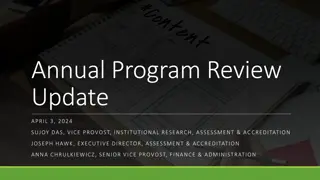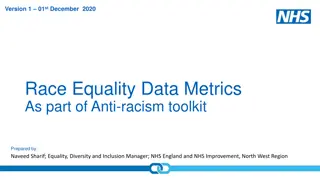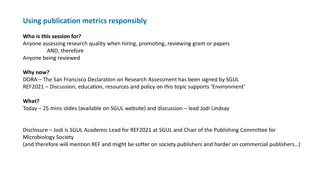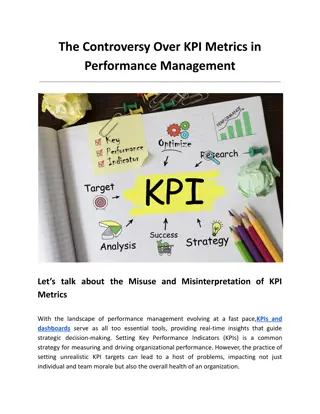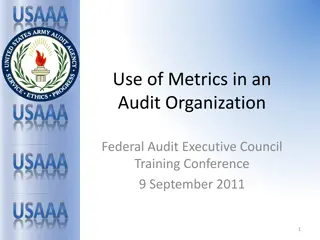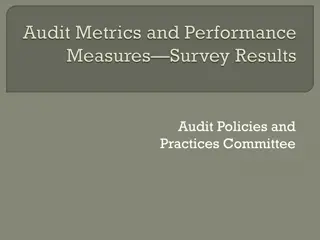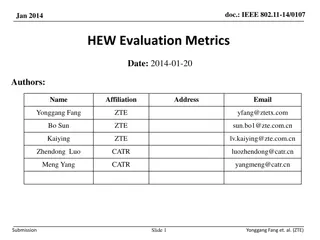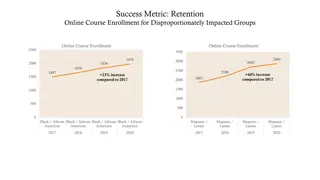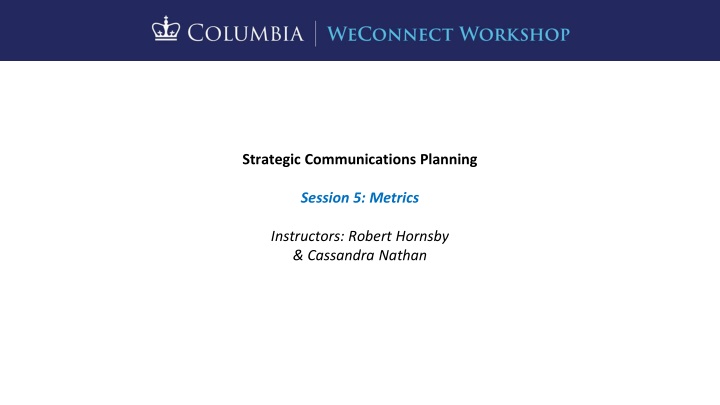
Metrics in Strategic Communications Planning
Explore the importance of metrics in strategic communications planning sessions, learn how to define and measure success through various metrics, and understand the impact of choosing the right metrics on your communication goals and strategies.
Download Presentation

Please find below an Image/Link to download the presentation.
The content on the website is provided AS IS for your information and personal use only. It may not be sold, licensed, or shared on other websites without obtaining consent from the author. If you encounter any issues during the download, it is possible that the publisher has removed the file from their server.
You are allowed to download the files provided on this website for personal or commercial use, subject to the condition that they are used lawfully. All files are the property of their respective owners.
The content on the website is provided AS IS for your information and personal use only. It may not be sold, licensed, or shared on other websites without obtaining consent from the author.
E N D
Presentation Transcript
Strategic Communications Planning Session 5: Metrics Instructors: Robert Hornsby & Cassandra Nathan
Review of session 4 Tactics: How did it go? What was easiest piece to define or explain? What was the hardest piece to define or explain?
Refresher: Elements of a Communications Plan Situation Analysis Goals the WHY Strategy the WHAT Tactics the HOW Metrics Evaluation 1. 2. 3. 4. 5. 6.
A philosophical digression about Metrics: Fundamental truth: What we decide to measure defines who we are and what we do. As soon as someone declares what metric we re going to use to track our progress, attention pivots toward that metric. People change, the work changes, the output changes. Choose your metrics wisely. -Paraphrased from Steve Mulder, Director of Audience Insights (NPR) and Mark Fuerst, Director (Public Media Futures Forums)
Metrics Defined: Metrics are the facts derived from measurement, in this case, measurements about your communications tactics. Metrics quantify tactics; they can also provide qualitative feedback about content. Metrics document success of your call to action. Metrics can also allow for testing and readjustment of both messages and tactics. Metrics are a tool to help judge engagement. Metrics can also tell you if your strategy is working and achieving your communication goals. Like Tactics, your Metrics need timelines a beginning, middle and an end point. There is no one size fits all metric. Depending on your tactics, you will likely need a combination of metrics to fully capture and judge the effectiveness of your communications.
What are you Measuring?* If you want to measure exposure, then use metrics like volume, reach, exposure, and amplification. o Circulation (print subscribers/buyers) o How far is your message spreading (reach)? If you want to measure engagement, then look for metrics around retweets, comments, replies, and participants. o How many people are participating? o How often are they participating o In what forms are they participating? *Adapted from from Neil Patel, author & co-founder of NP Digital and Subscribe
What are you Measuring?* If your goal is to drive traffic to your website, then track URL shares, clicks and conversions. o Are people moving through social media to your website? o What do visitors they do once they are on your website? If your goal is to find advocates and fans, then track contributors and influence. o Who is participating and what kind of impact do they have? If your goal is to increase your brand s share of voice, then track your volume relative to your closest competitors. o How much of the overall conversation around your industry or product category is about your brand? *Adapted from from Neil Patel, author & co-founder of NP Digital and Subscribe
About Metrics: What is Engagement? Passive reception of your communications is not strategic. For messages to be truly effective, audiences must be moved to take action to support your organization. Engagement is an action taken by your audiences. Discussion questions: Which metrics reflect passive audiences and which reflect engaged audiences? In your target audiences, is there a difference between exposure and understanding?
Name some common metrics for communications: Subscribers or circulation numbers Page views Unique visitors Shares, likes Re-posts, retweets Threads, comments Number of citations of your principals in news articles What is missing from this list?
Common metrics systems & types of data: Analog World: o Circulation (print subscribers/buyers) o Impressions (circulation + pass-along rate) o Nielsen ratings sample of TV viewers & radio listeners Digital Media: o Page views aka eyeballs o Unique visitors o Source of traffic (from origin URL to your webpage) Social Media: o Likes & shares: Facebook, Twitter (retweets), LinkedIn o Comments, threads, dialogue o Click-throughs (hyperlink clicks from one online item to another) o Reach (organic vs. paid)
IntroducingAlternative metrics: Event attendance Opting in to an enewsletter or RSS feed Audience surveys Polls Focus groups Random sampling of audience(s) Participation rates in volunteer programs, alumni groups, etc. Fundraising participation and dollars Others?
Metrics -- Discussion questions: Translating ideas into our work are we measuring the tactics correctly and in ways that are meaningful to planning? In line with our discussion about valued audiences, how do we measure our success with the audiences we most value? Are we breaking through the noise, i.e. are the target audiences both receiving and absorbing the message(s)? Are our messages resonating with our audience(s)? How would you learn that? How can we judge positive/neutral/negative sentiment? Are the target audiences acting on our call to action? How? Which metric(s) provides the most value?
Open discussion: Identify three metrics of your plan -- ones that your currently gather, or ones that you will gather in future. Breakout session: Focus on metrics of your school/dept/unit.
Homework: Make substantive comments on Master plan documents and especially about Tactics by your teammates. Insert 1-page (minimum) Metrics into your Master plan -- due next Thursday
Supplement Tools for metrics: Web tracking: o Google search/Google alerts o Google (web) Analytics: https://marketingplatform.google.com/about/analytics/?hl=en_US o QR code on displays & graphics Social media tools: o Facebook Analytics: https://analytics.facebook.com o Twitter Analytics: https://analytics.twitter.com/about Media vendor services: o Media-monitoring services Cision, Meltwater, MuckRack
References: To build and engage your audience, consider these core metrics for measuring success https://current.org/2018/03/to-build-and-engage-your-audience-consider-these-core-metrics- for-measuring-success/?wallit_nosession=1 (PPT slide handout relates to this article) 50 ways to measure your analytics (with apologies to Paul Simon) https://www.poynter.org/tech-tools/2016/50-ways-to-measure-your-analytics-with-apologies-to- paul-simon/ Google Analytics homepage: https://marketingplatform.google.com/about/analytics/?hl=en_US Social media measurement: https://neilpatel.com/blog/social-media-measurement/
References: To learn more about TV, see: http://ratingsacademy.nielsen.com For radio see: https://tlr.nielsen.com/tlr/public/market.do?method=loadAllMa Radio facts & figures: https://newsgeneration.com/broadcast-resources/radio-facts-and-figures/


